MBA Marketing Management: Pricing Strategies and Communication System
VerifiedAdded on 2023/06/15
|6
|1463
|179
Homework Assignment
AI Summary
This marketing assignment provides a detailed analysis of various key concepts in marketing management. It begins by comparing and contrasting market-skimming and market-penetration pricing strategies, providing real-world examples like Apple and Samsung. It then explains how pricing sends different signals to customers, competitors, and collaborators, influencing perceptions of quality, competitive positioning, and profitability. The assignment further explores the five product levels—core benefit, generic product, expected product, augmented product, and potential product—using Samsung mobile devices as an example. It also elucidates the concept of an integrated communication system and its importance in coordinating various marketing channels. Finally, it discusses price discrimination, explaining how marketers charge different prices based on geographical differences and price elasticity. This comprehensive analysis provides a solid understanding of pricing strategies, product development, and marketing communication.
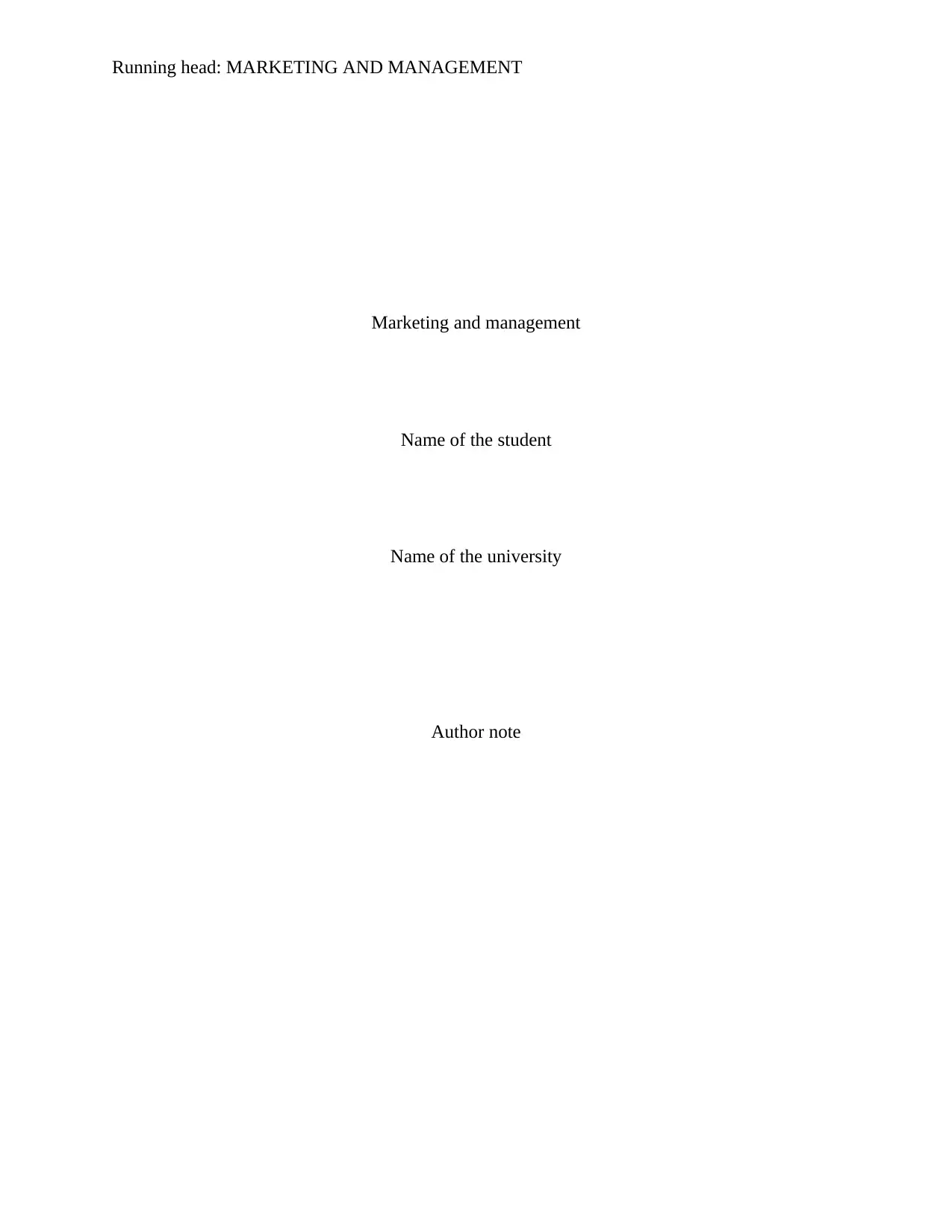
Running head: MARKETING AND MANAGEMENT
Marketing and management
Name of the student
Name of the university
Author note
Marketing and management
Name of the student
Name of the university
Author note
Paraphrase This Document
Need a fresh take? Get an instant paraphrase of this document with our AI Paraphraser
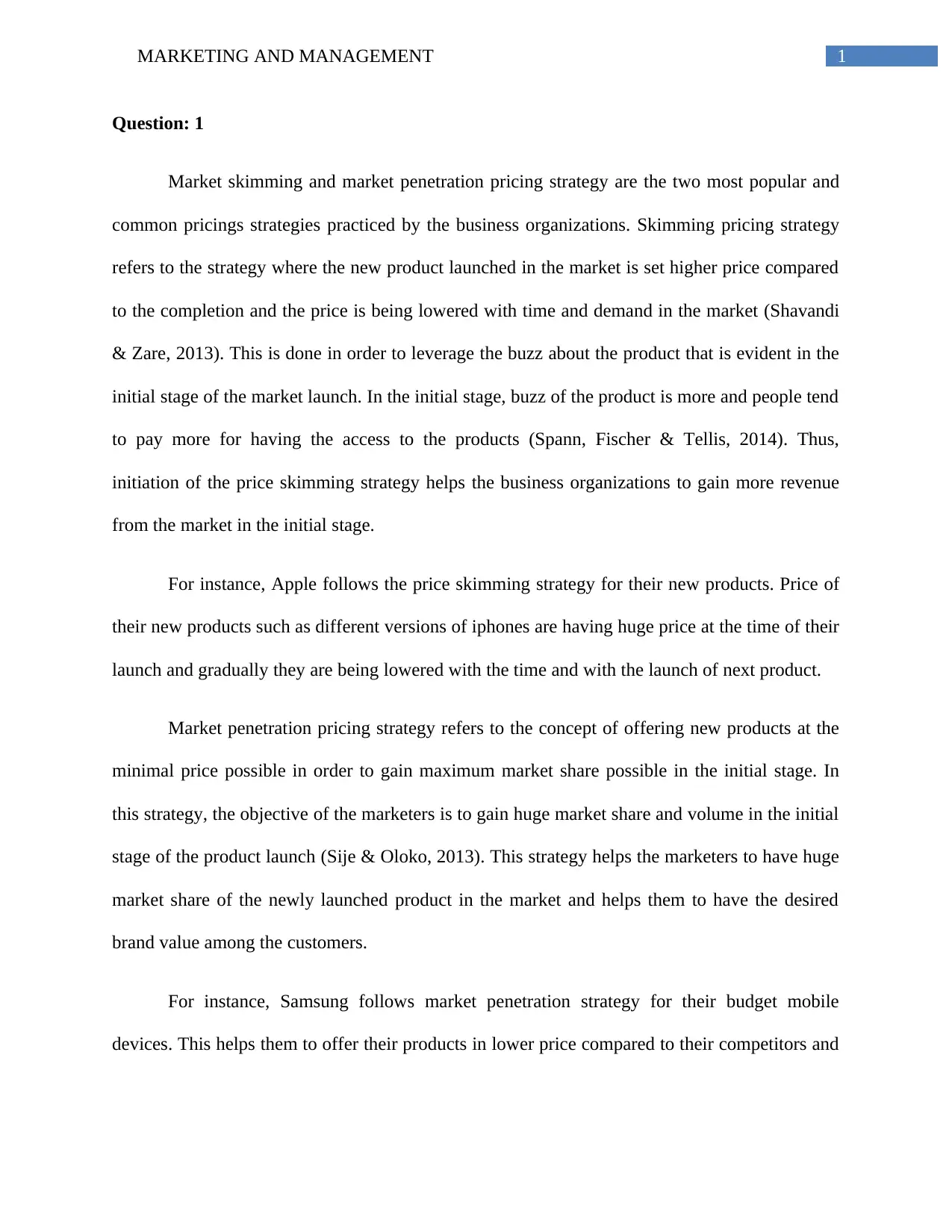
1MARKETING AND MANAGEMENT
Question: 1
Market skimming and market penetration pricing strategy are the two most popular and
common pricings strategies practiced by the business organizations. Skimming pricing strategy
refers to the strategy where the new product launched in the market is set higher price compared
to the completion and the price is being lowered with time and demand in the market (Shavandi
& Zare, 2013). This is done in order to leverage the buzz about the product that is evident in the
initial stage of the market launch. In the initial stage, buzz of the product is more and people tend
to pay more for having the access to the products (Spann, Fischer & Tellis, 2014). Thus,
initiation of the price skimming strategy helps the business organizations to gain more revenue
from the market in the initial stage.
For instance, Apple follows the price skimming strategy for their new products. Price of
their new products such as different versions of iphones are having huge price at the time of their
launch and gradually they are being lowered with the time and with the launch of next product.
Market penetration pricing strategy refers to the concept of offering new products at the
minimal price possible in order to gain maximum market share possible in the initial stage. In
this strategy, the objective of the marketers is to gain huge market share and volume in the initial
stage of the product launch (Sije & Oloko, 2013). This strategy helps the marketers to have huge
market share of the newly launched product in the market and helps them to have the desired
brand value among the customers.
For instance, Samsung follows market penetration strategy for their budget mobile
devices. This helps them to offer their products in lower price compared to their competitors and
Question: 1
Market skimming and market penetration pricing strategy are the two most popular and
common pricings strategies practiced by the business organizations. Skimming pricing strategy
refers to the strategy where the new product launched in the market is set higher price compared
to the completion and the price is being lowered with time and demand in the market (Shavandi
& Zare, 2013). This is done in order to leverage the buzz about the product that is evident in the
initial stage of the market launch. In the initial stage, buzz of the product is more and people tend
to pay more for having the access to the products (Spann, Fischer & Tellis, 2014). Thus,
initiation of the price skimming strategy helps the business organizations to gain more revenue
from the market in the initial stage.
For instance, Apple follows the price skimming strategy for their new products. Price of
their new products such as different versions of iphones are having huge price at the time of their
launch and gradually they are being lowered with the time and with the launch of next product.
Market penetration pricing strategy refers to the concept of offering new products at the
minimal price possible in order to gain maximum market share possible in the initial stage. In
this strategy, the objective of the marketers is to gain huge market share and volume in the initial
stage of the product launch (Sije & Oloko, 2013). This strategy helps the marketers to have huge
market share of the newly launched product in the market and helps them to have the desired
brand value among the customers.
For instance, Samsung follows market penetration strategy for their budget mobile
devices. This helps them to offer their products in lower price compared to their competitors and
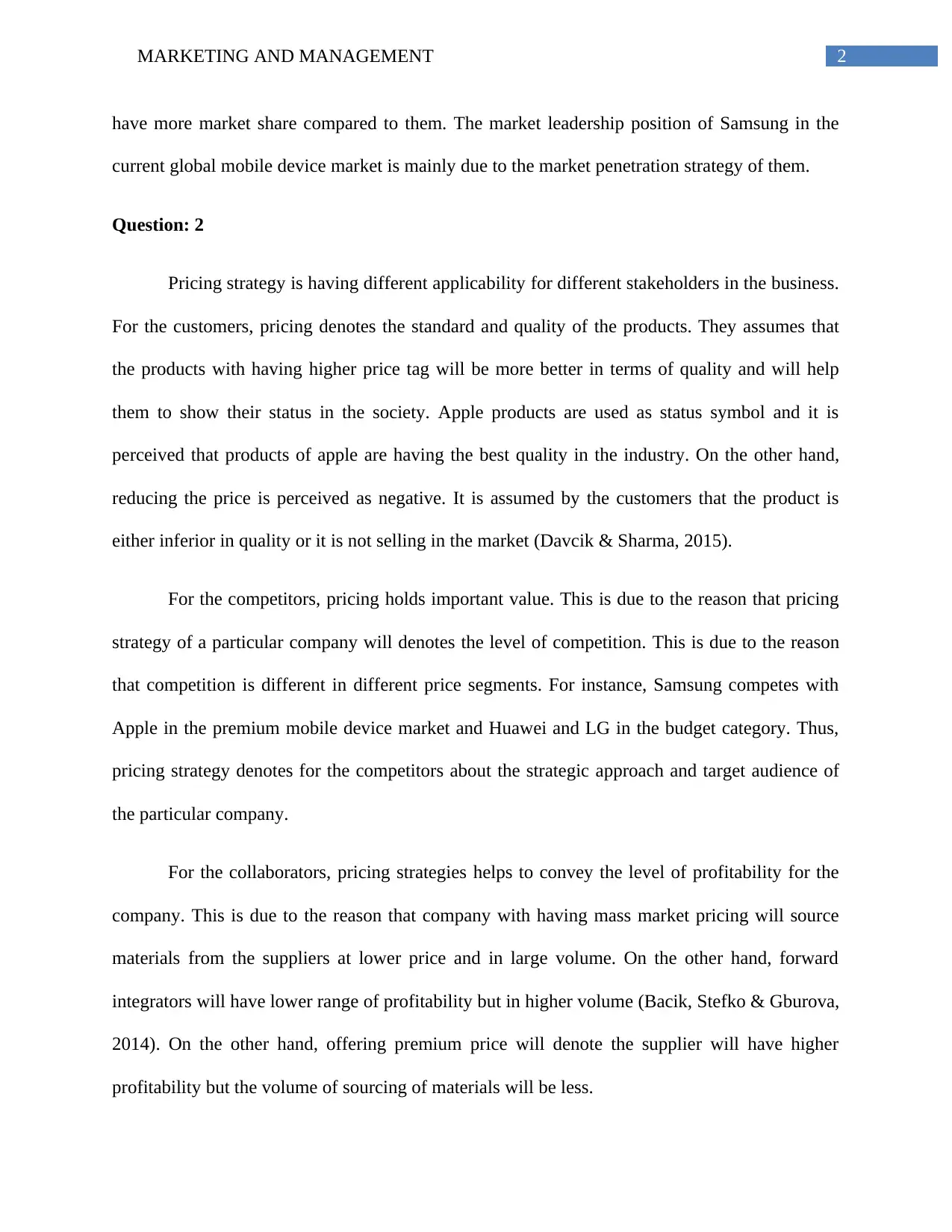
2MARKETING AND MANAGEMENT
have more market share compared to them. The market leadership position of Samsung in the
current global mobile device market is mainly due to the market penetration strategy of them.
Question: 2
Pricing strategy is having different applicability for different stakeholders in the business.
For the customers, pricing denotes the standard and quality of the products. They assumes that
the products with having higher price tag will be more better in terms of quality and will help
them to show their status in the society. Apple products are used as status symbol and it is
perceived that products of apple are having the best quality in the industry. On the other hand,
reducing the price is perceived as negative. It is assumed by the customers that the product is
either inferior in quality or it is not selling in the market (Davcik & Sharma, 2015).
For the competitors, pricing holds important value. This is due to the reason that pricing
strategy of a particular company will denotes the level of competition. This is due to the reason
that competition is different in different price segments. For instance, Samsung competes with
Apple in the premium mobile device market and Huawei and LG in the budget category. Thus,
pricing strategy denotes for the competitors about the strategic approach and target audience of
the particular company.
For the collaborators, pricing strategies helps to convey the level of profitability for the
company. This is due to the reason that company with having mass market pricing will source
materials from the suppliers at lower price and in large volume. On the other hand, forward
integrators will have lower range of profitability but in higher volume (Bacik, Stefko & Gburova,
2014). On the other hand, offering premium price will denote the supplier will have higher
profitability but the volume of sourcing of materials will be less.
have more market share compared to them. The market leadership position of Samsung in the
current global mobile device market is mainly due to the market penetration strategy of them.
Question: 2
Pricing strategy is having different applicability for different stakeholders in the business.
For the customers, pricing denotes the standard and quality of the products. They assumes that
the products with having higher price tag will be more better in terms of quality and will help
them to show their status in the society. Apple products are used as status symbol and it is
perceived that products of apple are having the best quality in the industry. On the other hand,
reducing the price is perceived as negative. It is assumed by the customers that the product is
either inferior in quality or it is not selling in the market (Davcik & Sharma, 2015).
For the competitors, pricing holds important value. This is due to the reason that pricing
strategy of a particular company will denotes the level of competition. This is due to the reason
that competition is different in different price segments. For instance, Samsung competes with
Apple in the premium mobile device market and Huawei and LG in the budget category. Thus,
pricing strategy denotes for the competitors about the strategic approach and target audience of
the particular company.
For the collaborators, pricing strategies helps to convey the level of profitability for the
company. This is due to the reason that company with having mass market pricing will source
materials from the suppliers at lower price and in large volume. On the other hand, forward
integrators will have lower range of profitability but in higher volume (Bacik, Stefko & Gburova,
2014). On the other hand, offering premium price will denote the supplier will have higher
profitability but the volume of sourcing of materials will be less.
⊘ This is a preview!⊘
Do you want full access?
Subscribe today to unlock all pages.

Trusted by 1+ million students worldwide
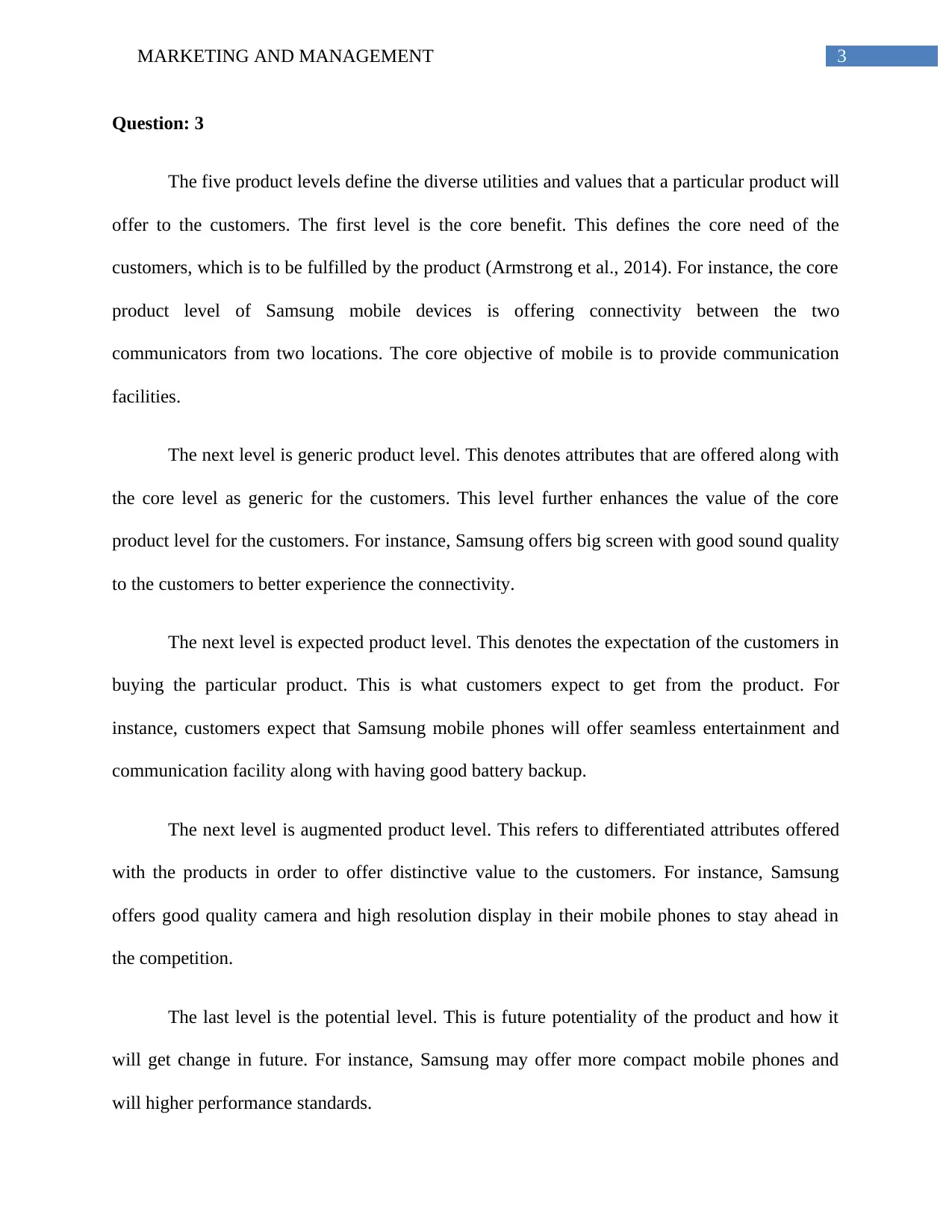
3MARKETING AND MANAGEMENT
Question: 3
The five product levels define the diverse utilities and values that a particular product will
offer to the customers. The first level is the core benefit. This defines the core need of the
customers, which is to be fulfilled by the product (Armstrong et al., 2014). For instance, the core
product level of Samsung mobile devices is offering connectivity between the two
communicators from two locations. The core objective of mobile is to provide communication
facilities.
The next level is generic product level. This denotes attributes that are offered along with
the core level as generic for the customers. This level further enhances the value of the core
product level for the customers. For instance, Samsung offers big screen with good sound quality
to the customers to better experience the connectivity.
The next level is expected product level. This denotes the expectation of the customers in
buying the particular product. This is what customers expect to get from the product. For
instance, customers expect that Samsung mobile phones will offer seamless entertainment and
communication facility along with having good battery backup.
The next level is augmented product level. This refers to differentiated attributes offered
with the products in order to offer distinctive value to the customers. For instance, Samsung
offers good quality camera and high resolution display in their mobile phones to stay ahead in
the competition.
The last level is the potential level. This is future potentiality of the product and how it
will get change in future. For instance, Samsung may offer more compact mobile phones and
will higher performance standards.
Question: 3
The five product levels define the diverse utilities and values that a particular product will
offer to the customers. The first level is the core benefit. This defines the core need of the
customers, which is to be fulfilled by the product (Armstrong et al., 2014). For instance, the core
product level of Samsung mobile devices is offering connectivity between the two
communicators from two locations. The core objective of mobile is to provide communication
facilities.
The next level is generic product level. This denotes attributes that are offered along with
the core level as generic for the customers. This level further enhances the value of the core
product level for the customers. For instance, Samsung offers big screen with good sound quality
to the customers to better experience the connectivity.
The next level is expected product level. This denotes the expectation of the customers in
buying the particular product. This is what customers expect to get from the product. For
instance, customers expect that Samsung mobile phones will offer seamless entertainment and
communication facility along with having good battery backup.
The next level is augmented product level. This refers to differentiated attributes offered
with the products in order to offer distinctive value to the customers. For instance, Samsung
offers good quality camera and high resolution display in their mobile phones to stay ahead in
the competition.
The last level is the potential level. This is future potentiality of the product and how it
will get change in future. For instance, Samsung may offer more compact mobile phones and
will higher performance standards.
Paraphrase This Document
Need a fresh take? Get an instant paraphrase of this document with our AI Paraphraser
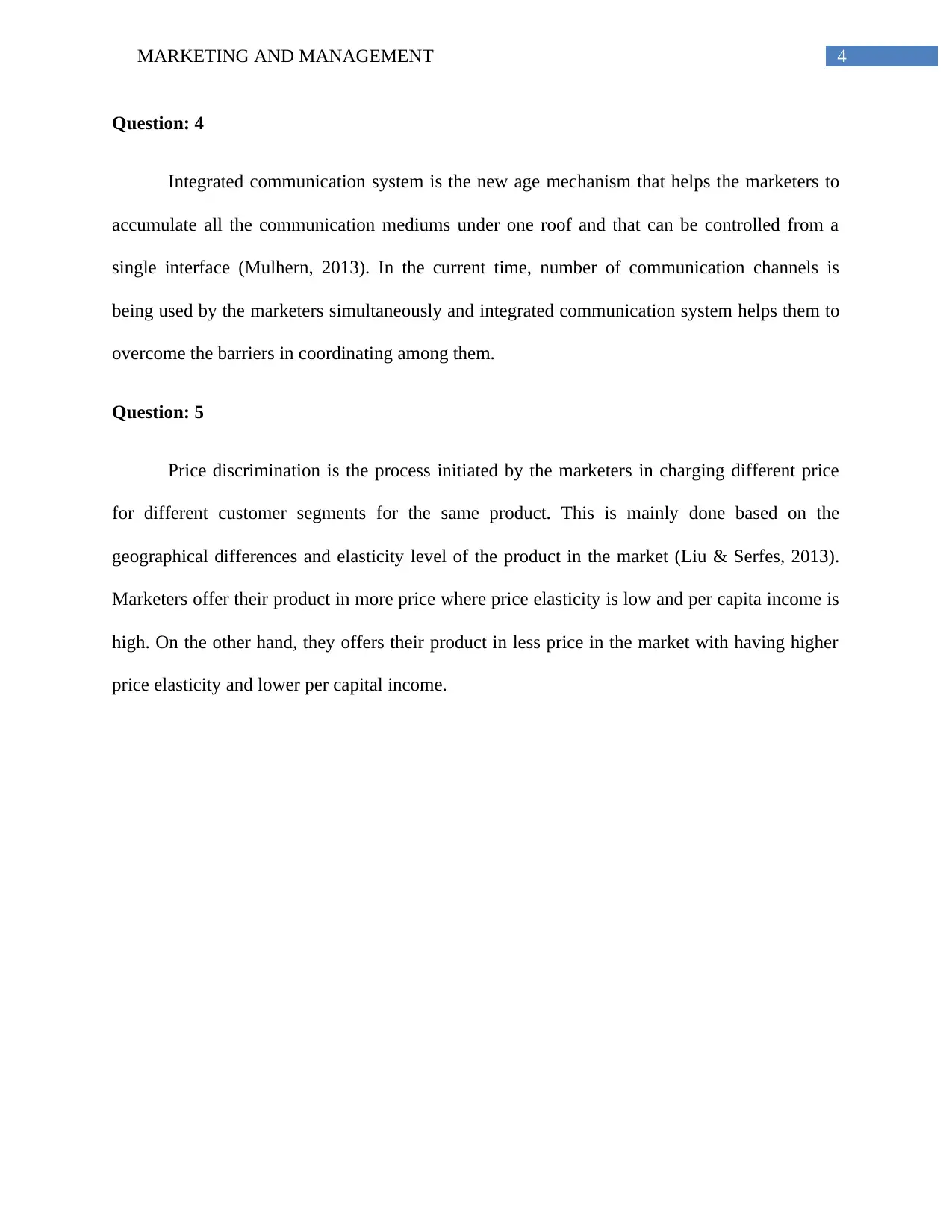
4MARKETING AND MANAGEMENT
Question: 4
Integrated communication system is the new age mechanism that helps the marketers to
accumulate all the communication mediums under one roof and that can be controlled from a
single interface (Mulhern, 2013). In the current time, number of communication channels is
being used by the marketers simultaneously and integrated communication system helps them to
overcome the barriers in coordinating among them.
Question: 5
Price discrimination is the process initiated by the marketers in charging different price
for different customer segments for the same product. This is mainly done based on the
geographical differences and elasticity level of the product in the market (Liu & Serfes, 2013).
Marketers offer their product in more price where price elasticity is low and per capita income is
high. On the other hand, they offers their product in less price in the market with having higher
price elasticity and lower per capital income.
Question: 4
Integrated communication system is the new age mechanism that helps the marketers to
accumulate all the communication mediums under one roof and that can be controlled from a
single interface (Mulhern, 2013). In the current time, number of communication channels is
being used by the marketers simultaneously and integrated communication system helps them to
overcome the barriers in coordinating among them.
Question: 5
Price discrimination is the process initiated by the marketers in charging different price
for different customer segments for the same product. This is mainly done based on the
geographical differences and elasticity level of the product in the market (Liu & Serfes, 2013).
Marketers offer their product in more price where price elasticity is low and per capita income is
high. On the other hand, they offers their product in less price in the market with having higher
price elasticity and lower per capital income.
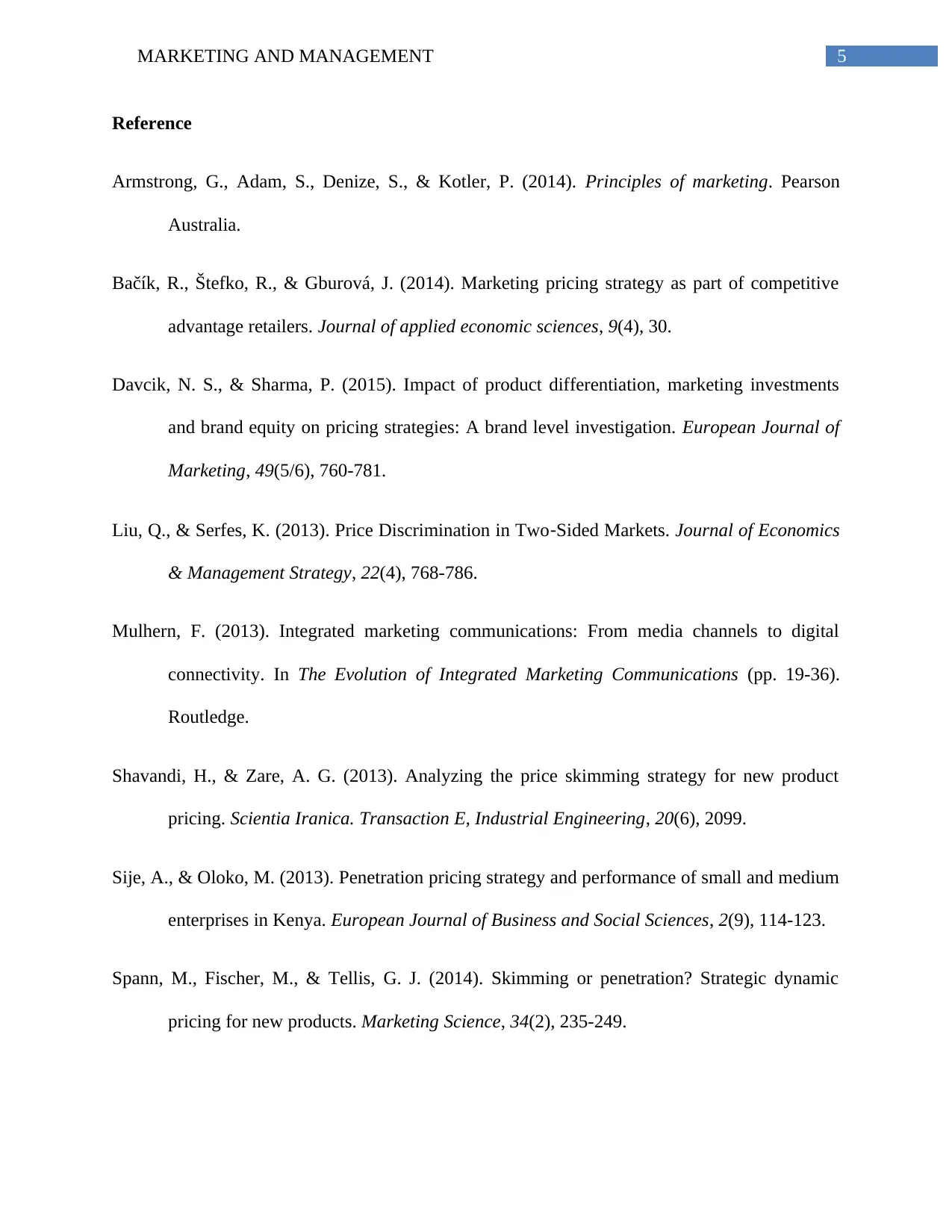
5MARKETING AND MANAGEMENT
Reference
Armstrong, G., Adam, S., Denize, S., & Kotler, P. (2014). Principles of marketing. Pearson
Australia.
Bačík, R., Štefko, R., & Gburová, J. (2014). Marketing pricing strategy as part of competitive
advantage retailers. Journal of applied economic sciences, 9(4), 30.
Davcik, N. S., & Sharma, P. (2015). Impact of product differentiation, marketing investments
and brand equity on pricing strategies: A brand level investigation. European Journal of
Marketing, 49(5/6), 760-781.
Liu, Q., & Serfes, K. (2013). Price Discrimination in Two‐Sided Markets. Journal of Economics
& Management Strategy, 22(4), 768-786.
Mulhern, F. (2013). Integrated marketing communications: From media channels to digital
connectivity. In The Evolution of Integrated Marketing Communications (pp. 19-36).
Routledge.
Shavandi, H., & Zare, A. G. (2013). Analyzing the price skimming strategy for new product
pricing. Scientia Iranica. Transaction E, Industrial Engineering, 20(6), 2099.
Sije, A., & Oloko, M. (2013). Penetration pricing strategy and performance of small and medium
enterprises in Kenya. European Journal of Business and Social Sciences, 2(9), 114-123.
Spann, M., Fischer, M., & Tellis, G. J. (2014). Skimming or penetration? Strategic dynamic
pricing for new products. Marketing Science, 34(2), 235-249.
Reference
Armstrong, G., Adam, S., Denize, S., & Kotler, P. (2014). Principles of marketing. Pearson
Australia.
Bačík, R., Štefko, R., & Gburová, J. (2014). Marketing pricing strategy as part of competitive
advantage retailers. Journal of applied economic sciences, 9(4), 30.
Davcik, N. S., & Sharma, P. (2015). Impact of product differentiation, marketing investments
and brand equity on pricing strategies: A brand level investigation. European Journal of
Marketing, 49(5/6), 760-781.
Liu, Q., & Serfes, K. (2013). Price Discrimination in Two‐Sided Markets. Journal of Economics
& Management Strategy, 22(4), 768-786.
Mulhern, F. (2013). Integrated marketing communications: From media channels to digital
connectivity. In The Evolution of Integrated Marketing Communications (pp. 19-36).
Routledge.
Shavandi, H., & Zare, A. G. (2013). Analyzing the price skimming strategy for new product
pricing. Scientia Iranica. Transaction E, Industrial Engineering, 20(6), 2099.
Sije, A., & Oloko, M. (2013). Penetration pricing strategy and performance of small and medium
enterprises in Kenya. European Journal of Business and Social Sciences, 2(9), 114-123.
Spann, M., Fischer, M., & Tellis, G. J. (2014). Skimming or penetration? Strategic dynamic
pricing for new products. Marketing Science, 34(2), 235-249.
⊘ This is a preview!⊘
Do you want full access?
Subscribe today to unlock all pages.

Trusted by 1+ million students worldwide
1 out of 6
Related Documents
Your All-in-One AI-Powered Toolkit for Academic Success.
+13062052269
info@desklib.com
Available 24*7 on WhatsApp / Email
![[object Object]](/_next/static/media/star-bottom.7253800d.svg)
Unlock your academic potential
Copyright © 2020–2025 A2Z Services. All Rights Reserved. Developed and managed by ZUCOL.





